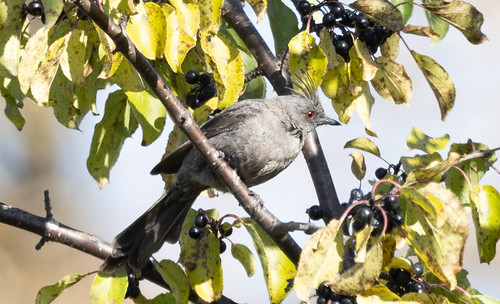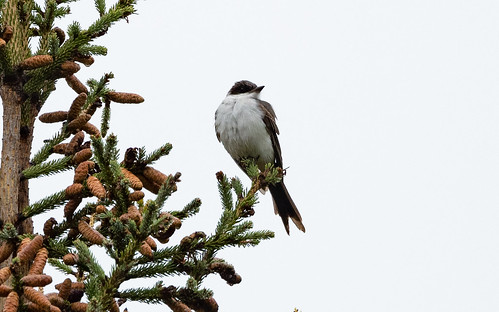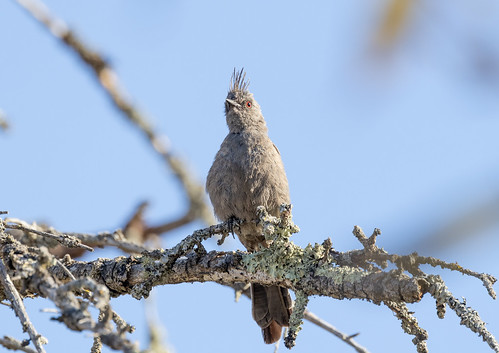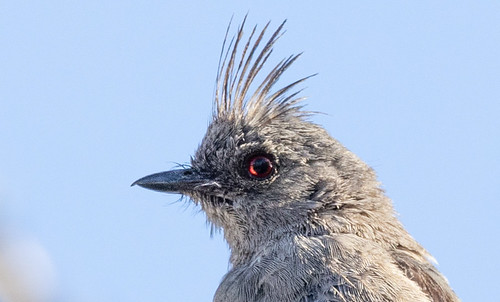On Saturday, October 29, word went out that a Phainopepla had turned up near the parking area of the McQuade Boat Landing just up the shore from Duluth. I was in the first crowd of people to see this first state record after Molly Misfeldt and Michael Sack reported it.
The bird stuck around all weekend and all day Monday, and was still there on Tuesday, November 1. I didn’t need to babysit until mid-afternoon, so I went back a couple of times to get better photos and a sound recording, along with bragging rights about seeing this extraordinary bird in Minnesota in two calendar months. There were still birders watching it when I left, but it wasn’t seen again after that day. I felt bad for out-of-town birders who wanted to see it on Wednesday, but I was also relieved, hopeful that the bird left on its own power, not in the grips of a Sharp-shinned Hawk. I thought about the Saturday morning cartoons when I was a little girl, with a clueless sheriff trying to catch some speedy prankster like Wile E. Coyote and asking in a cartoonish voice, “Which way did he go?” There is at least some hope that the Phainopepla headed toward the Roadrunner's habitat in the Southwest, but we’ll never know for sure.
Scientists simply do not know what makes some individual birds wander well out of their normal range, but vagrancy happens fairly frequently in a few species. The Fork-tailed Flycatcher that turned up at Stony Point this spring was even further out of its range than the Phainopepla. Fork-tailed Flycatchers that wander into the United States tend to be from the South American population that migrates fairly long distances, while Phainopeplas migrate much shorter distances, yet that Fork-tail was Minnesota’s fourth state record, the second to be reported in St. Louis County, and they appear at least somewhere in the United States just about every year. Some ornithologists speculate that the migratory compass of vagrant Fork-tailed Flycatchers somehow got reversed. But there are only a handful of records ever of Phainopeplas anywhere out of the Southwest and California. How did one end up in Duluth?
Jaegers and Sabine’s Gulls do not belong on Lake Superior, but every fall there are several sightings of Parasitic Jaegers, a handful of Pomarine Jaegers, once in a while a Long-tailed Jaeger, and usually one or two Sabine’s Gulls, seen right here in Duluth and Superior. The individuals are vagrants, but of species in which some individuals always wander. The Ivory Gull that showed up in Canal Park in Duluth in 2016 was the 12th state record; this past January Minnesota birders found the state’s 13th record.
If no one understands what makes some individual wander, we have even less understanding of whether any of them ever get back to where they belong. Vagrants that linger a while may be in trouble—the Ivory Gull that appeared in Duluth on January 1, 2016, stuck around Canal Park for over three weeks but ended up dying on January 24; oddly enough, during the time that one was in Duluth, a different individual was found dead in Superior. But lingering isn’t always fatal. One banded female Rufous Hummingbird wintered in northern Massachusetts at least six years in a row.
Most exceptional vagrants appear out of the blue and disappear within days, or even hours or minutes. The Fork-tailed Flycatcher on Stoney Point September 17 this year was seen only a few times within a couple of hours before it disappeared for good. The only other Fork-tail ever seen in St. Louis County, in Duluth on September 6, 1991, was seen by only one person, Peder Svingen, and only for a few minutes. But the very next spring, one appeared in Grand Marais on May 3 and stuck around for 11 days. The only predictable thing about vagrant birds is their unpredictability.
I haven’t heard of any out-of-range Phainopeplas in the United States in the six days since the McQuade Harbor bird disappeared, and even if one turned up, we’d have no way of knowing for certain that it was “our” bird. Uncertainty and mystery are part of the magic of these sightings, and since our Phainopepla disappeared while the weather was still pleasant, there’s at least some hope that she’s been working her way back to familiar terrain in her natural range. Hope is the thing with feathers that perches in the soul, but my mind keeps going back to those Saturday morning cartoon sheriffs asking, “Which way did she go?”





